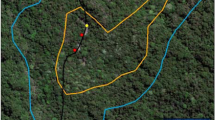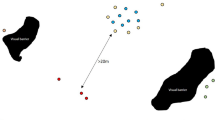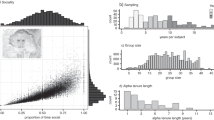Abstract
Social relationships are important to many aspects of animals’ lives, and an individual’s connections may change over the course of their lifespan. Currently, it is unclear whether social connectedness declines within individuals as they age, and what the underlying mechanisms might be, so the role of age in structuring animal social systems remains unresolved, particularly in non-primates. Here we describe senescent declines in social connectedness using 46 years of data in a wild, individually monitored population of a long-lived mammal (European red deer, Cervus elaphus). Applying a series of spatial and social network analyses, we demonstrate that these declines occur because of within-individual changes in social behaviour, with correlated changes in spatial behaviour (smaller home ranges and movements to lower-density, lower-quality areas). These findings demonstrate that within-individual socio-spatial behavioural changes can lead older animals in fission–fusion societies to become less socially connected, shedding light on the ecological and evolutionary processes structuring wild animal populations.
This is a preview of subscription content, access via your institution
Access options
Access Nature and 54 other Nature Portfolio journals
Get Nature+, our best-value online-access subscription
$29.99 / 30 days
cancel any time
Subscribe to this journal
Receive 12 digital issues and online access to articles
$119.00 per year
only $9.92 per issue
Buy this article
- Purchase on Springer Link
- Instant access to full article PDF
Prices may be subject to local taxes which are calculated during checkout



Similar content being viewed by others
Data availability
All data are available at https://github.com/gfalbery/Lonely-Old-Deers.
Code availability
All code are available at https://github.com/gfalbery/Lonely-Old-Deers.
References
White, L. A., Forester, J. D. & Craft, M. E. Using contact networks to explore mechanisms of parasite transmission in wildlife. Biol. Rev. 92, 389–409 (2017).
Silk, M. J. et al. Using social network measures in wildlife disease ecology, epidemiology, and management. Bioscience 67, 245–257 (2017).
Albery, G. F., Kirkpatrick, L., Firth, J. A. & Bansal, S. Unifying spatial and social network analysis in disease ecology. J. Anim. Ecol. 90, 1–17 (2021).
Evans, J. C., Silk, M. J., Boogert, N. J. & Hodgson, D. J. Infected or informed? Social structure and the simultaneous transmission of information and infectious disease. Oikos 129, 1271–1288 (2020).
Aplin, L. M., Sheldon, B. C. & Morand-Ferron, J. Milk bottles revisited: social learning and individual variation in the blue tit, Cyanistes caeruleus. Anim. Behav. 85, 1225–1232 (2013).
Silk, J. B. The adaptive value of sociality in mammalian groups. Phil. Trans. R. Soc. Lond. B 362, 539–559 (2007).
Snyder-Mackler, N. et al. Social determinants of health and survival in humans and other animals. Science 368, eaax9553 (2020).
Machanda, Z. P. & Rosati, A. G. Shifting sociality during primate ageing. Phil. Trans. R. Soc. B 375, 20190620 (2020).
Nussey, D. H., Coulson, T., Festa-Bianchet, M. & Gaillard, J. M. Measuring senescence in wild animal populations: towards a longitudinal approach. Funct. Ecol. 22, 393–406 (2008).
van de Pol, M. & Verhulst, S. Age-dependent traits: a new statistical model to separate within- and between-individual effects. Am. Nat. 167, 766–773 (2006).
Froy, H. et al. Declining home range area predicts reduced late-life survival in two wild ungulate populations. Ecol. Lett. 21, 1001–1009 (2018).
Rosati, A. G. et al. Social selectivity in aging wild chimpanzees. Science 370, 473–476 (2020).
Kim, S.-Y., Torres, R., Rodriguez, C. & Drummond, H. Effects of breeding success, mate fidelity and senescence on breeding dispersal of male and female blue-footed boobies. J. Anim. Ecol. 76, 471–479 (2007).
Webber, Q. M. R. & Vander Wal, E. An evolutionary framework outlining the integration of individual social and spatial ecology. J. Anim. Ecol. 87, 113–127 (2018).
Webber, Q. M. R. & Vander Wal, E. Trends and perspectives on the use of animal social network analysis in behavioural ecology: a bibliometric approach. Anim. Behav. 149, 77–87 (2019).
Siracusa, E. R., Higham, J. P., Snyder-mackler, N. & Brent, L. J. N. Social ageing: exploring the drivers of late-life changes in social behaviour in mammals. Biol. Lett. 18, 20210643 (2022).
Elliott, K. H. et al. Ageing gracefully: physiology but not behaviour declines with age in a diving seabird. Funct. Ecol. 29, 219–228 (2015).
Aartsen, M. J., Van Tilburg, T., Smits, C. H. M. & Knipscheer, K. C. P. M. A longitudinal study of the impact of physical and cognitive decline on the personal network in old age. J. Soc. Pers. Relat. 21, 249–266 (2004).
Brent, L. J. N., Ruiz-Lambides, A. & Platt, M. L. Family network size and survival across the lifespan of female macaques. Proc. R. Soc. B 284, 20170515 (2017).
Turner, J. W., Robitaille, A. L., Bills, P. S. & Holekamp, K. E. Early-life relationships matter: social position during early life predicts fitness among female spotted hyenas. J. Anim. Ecol. 90, 183–196 (2021).
Almeling, L., Hammerschmidt, K., Sennhenn-Reulen, H., Freund, A. M. & Fischer, J. Motivational shifts in aging monkeys and the origins of social selectivity. Curr. Biol. 26, 1744–1749 (2016).
Albery, G. F. et al. Multiple spatial behaviours govern social network positions in a wild ungulate. Ecol. Lett. 24, 676–686 (2021).
Sanchez, J. N. & Hudgens, B. R. Interactions between density, home range behaviors, and contact rates in the Channel Island fox (Urocyon littoralis). Ecol. Evol. 5, 2466–2477 (2015).
Shizuka, D. & Johnson, A. E. How demographic processes shape animal social networks. Behav. Ecol. https://doi.org/10.1093/beheco/arz083 (2019).
Krause, J., James, R., Franks, D. W. & Croft, D. P. Animal Social Networks (Oxford Univ. Press, 2015).
Firth, J. A. et al. Wild birds respond to flockmate loss by increasing their social network associations to others. Proc. R. Soc. B 284, 20170299 (2017).
Evans, J. C., Liechti, J. I., Boatman, B. & König, B. A natural catastrophic turnover event: individual sociality matters despite community resilience in wild house mice. Proc. R. Soc. B 287, 20192880 (2020).
Rathke, E. & Fischer, J. Social aging in male and female Barbary macaques. Am. J. Primatol. https://doi.org/10.1002/ajp.23272 (2021).
Kroeger, S. B., Blumstein, D. T. & Martin, J. G. A. A. How social behaviour and life-history traits change with age and in the year prior to death in female yellow-bellied marmots. Phil. Trans. R. Soc. B 376, 20190745 (2021).
Brambilla, A., von Hardenberg, A., Sueur, C., Canedoli, C. & Stanley, C. Long term analysis of social structure: evidence of age-based consistent associations in Alpine ibex. bioRxiv 1–42 (2021).
González, N. T. et al. Age-related change in adult chimpanzee social network integration. Evol. Med. Public Health 9, 448–459 (2021).
Clutton-Brock, T. H., Guinness, F. E. & Albon, S. D. Red Deer: Behavior and Ecology of Two Sexes. Vol. 15 (Univ. Chicago Press, 1982).
Nussey, D. H., Kruuk, L. E. B., Donald, A., Fowlie, M. & Clutton-Brock, T. H. The rate of senescence in maternal performance increases with early-life fecundity in red deer. Ecol. Lett. 9, 1342–1350 (2006).
Croft, D. P., James, R. & Krause, J. Exploring Animal Social Networks (Princeton Univ. Press, 2008).
Tobler, W. R. A computer movie simulating urban growth in the Detroit region. Econ. Geogr. 46, 234 (1970).
Firth, J. A. & Sheldon, B. C. Social carry-over effects underpin trans-seasonally linked structure in a wild bird population. Ecol. Lett. 19, 1324–1332 (2016).
Spiegel, O., Leu, S. T., Sih, A. & Bull, C. M. Socially interacting or indifferent neighbours? Randomization of movement paths to tease apart social preference and spatial constraints. Methods Ecol. Evol. https://doi.org/10.1111/2041-210X.12553 (2016).
Nussey, D. H. et al. The relationship between tooth wear, habitat quality and late-life reproduction in a wild red deer population. J. Anim. Ecol. 76, 402–412 (2007).
Loe, L. E., Mysterud, A., Langvatn, R. & Stenseth, N. C. Decelerating and sex-dependent tooth wear in Norwegian red deer. Oecologia 135, 346–353 (2003).
Peignier, M. et al. Space use and social association in a gregarious ungulate: testing the conspecific attraction and resource dispersion hypotheses. Ecol. Evol. 9, 5133–5145 (2019).
Franks, D. W., Ruxton, G. D. & James, R. Sampling animal association networks with the gambit of the group. Behav. Ecol. Sociobiol. 64, 493–503 (2010).
Patterson, S. K., Strum, S. C. & Silk, J. B. Resource competition shapes female–female aggression in olive baboons, Papio anubis. Anim. Behav. 176, 23–41 (2021).
Kays, R., Crofoot, M. C., Jetz, W. & Wikelski, M. Terrestrial animal tracking as an eye on life and planet. Science 348, aaa2478 (2015).
Gilbertson, M. L. J., White, L. A. & Craft, M. E. Trade‐offs with telemetry‐derived contact networks for infectious disease studies in wildlife. Methods Ecol. Evol. https://doi.org/10.1111/2041-210X.13355 (2020).
Froy, H. et al. Senescence in immunity against helminth parasites predicts adult mortality in a wild mammal. Science 365, 1296–1298 (2019).
Siracusa, E. R. et al. Familiar neighbors, but not relatives, enhance fitness in a territorial mammal. Curr. Biol. 31, 438–445.e3 (2021).
Nussey, D. H., Kruuk, L. E. B., Morris, A. & Clutton-Brock, T. H. Environmental conditions in early life influence ageing rates in a wild population of red deer. Curr. Biol. 17, 1000–1001 (2007).
Castles, M. et al. Social networks created with different techniques are not comparable. Anim. Behav. 96, 59–67 (2014).
Froy, H., Walling, C. A., Pemberton, J. M., Clutton-brock, T. H. & Kruuk, L. E. B. Relative costs of offspring sex and offspring survival in a polygynous mammal. Biol. Lett. 12, 20160417 (2016).
Clutton-Brock, T. H., Albon, S. D. & Guinness, F. E. Fitness costs of gestation and lactation in wild mammals. Nature 337, 260–262 (1989).
Cairns, S. J. & Schwager, S. J. A comparison of association indices. Anim. Behav. 35, 1454–1469 (1987).
Brent, L. J. N. Friends of friends: are indirect connections in social networks important to animal behaviour? Anim. Behav. 103, 211–222 (2015).
Whitehead, H. Analyzing Animal Societies: Quantitative Methods for Vertebrate Social Analysis (Univ. Chicago Press, 2008).
Calenge, C. Home range estimation in R: the adehabitatHR package. https://cran.r-project.org/web/packages/adehabitatHR/index.html (2011).
Lindgren, F. & Rue, H. Bayesian spatial modelling with R-INLA. J. Stat. Softw. 63, 1–25 (2015).
Rue, H. & Martino, S. Approximate Bayesian inference for latent Gaussian models by using integrated nested Laplace approximations. Stat. Methodol. 71, 319–392 (2009).
Bakka, H. et al. Spatial modelling with R-INLA: a review. WIREs Comput. Stat. 10, e1443 (2018).
Lindgren, F., Rue, H. & Lindstrom, J. An explicit link between Gaussian fields and Gaussian Markov random fields: the stochastic partial differential equation approach. J. R. Stat. Soc. B 73, 423–498 (2011).
Acknowledgements
We thank NatureScot and its predecessors for permission to work on the Isle of Rum NNR. The field project has been supported by grants mainly from the UK NERC with some additional funding from BBSRC, the Royal Society and ERC. We thank all who have contributed to the maintenance of the project over time, especially L. Kruuk. We thank multiple dedicated field workers who have contributed to field data collection, especially F. Guinness, who collected the first 20 years of census data. G.F.A. was funded by NSF grant number 1414296, and by a Bruce McEwen Career Development Fellowship from the NIH Animal Models for the Social Dimensions of Health and Aging Research Network (NIH/NIH R24 AG065172). J.A.F. was supported by BBSRC (BB/S009752/1) and funding from NERC (NE/S010335/1).
Author information
Authors and Affiliations
Contributions
G.F.A., D.H.N. and J.A.F. devised the analysis; G.F.A. carried out the analysis and wrote the manuscript. A.M. and S.M. collected behavioural data. T.H.C.-B., J.M.P., D.H.N. and J.A.F. commented on the manuscript. T.H.C.-B. and J.M.P. oversaw wider running of the project.
Corresponding author
Ethics declarations
Competing interests
We declare no competing interests.
Peer review
Peer review information
Nature Ecology & Evolution thanks the anonymous reviewers for their contribution to the peer review of this work.
Additional information
Publisher’s note Springer Nature remains neutral with regard to jurisdictional claims in published maps and institutional affiliations.
Extended data
Extended Data Fig. 1 Model effect estimates investigating how selective disappearance drives age-related changes in spatial behaviour (Model Set 5).
Each panel displays the model effect estimates for age and longevity for each spatial metric, demonstrating that selective disappearance was not responsible for the age-related changes in spatial behaviour, except in the case of density (a). Dots represent the mean of the posterior effect estimate distribution; error bars denote the 95% credibility intervals of the effect. The y axis is in units of standard deviations. NB density and centroid distance did not have an SPDE effect fitted to control for spatial autocorrelation because they are deterministically distributed in space, such that the SPDE effect would be uninformative.
Extended Data Fig. 2 Model estimates describing associations between spatial behaviours and social behaviours, and age-related declines in social behaviour when these variables were accounted for (Model Set 6).
Dots represent the mean of the posterior effect estimate distribution; error bars denote the 95% credibility intervals of the effect. These estimates are displayed both for the base model (a) and the SPDE model (b). HRA = home range area.
Extended Data Fig. 3 Model estimates for age effects on sociality in our longevity models (blue colours; Model Set 2); and in the same models with spatial behaviours accounted for (red colours; Model set 6).
Dots represent the mean of the posterior effect estimate distribution; error bars denote the 95% credibility intervals of the effect. Panel a displays the effects without an SPDE effect fitted; panel B displays the same effects with SPDE fitted.
Extended Data Fig. 4 Pairwise correlations among social (A) and spatial (B) behavioural metrics.
Panels that are more blue are more negative; panels that are more red are more positive.
Supplementary information
Supplementary Information
Tables of model effect estimates.
Rights and permissions
About this article
Cite this article
Albery, G.F., Clutton-Brock, T.H., Morris, A. et al. Ageing red deer alter their spatial behaviour and become less social. Nat Ecol Evol 6, 1231–1238 (2022). https://doi.org/10.1038/s41559-022-01817-9
Received:
Accepted:
Published:
Issue Date:
DOI: https://doi.org/10.1038/s41559-022-01817-9
This article is cited by
-
Social senescence in red deer
Nature Ecology & Evolution (2022)



